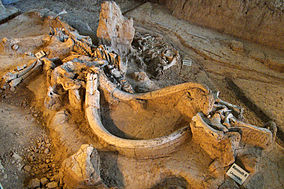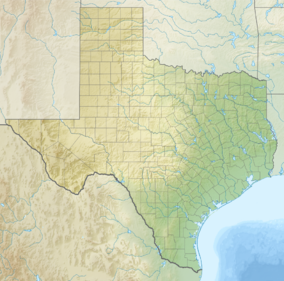Waco Mammoth National Monument
| Waco Mammoth National Monument | |
|---|---|

Columbian mammoth bull and juvenile remains at the Waco Mammoth National Monument
|
|
| Location | Waco, Texas |
| Coordinates | 31°36′21.6″N 97°10′30″W / 31.606000°N 97.17500°WCoordinates: 31°36′21.6″N 97°10′30″W / 31.606000°N 97.17500°W |
| Area | 5 acres (2.0 ha) |
| Created | July 10, 2015 |
| Governing body | National Park Service, City of Waco, Baylor University |
| Website | Waco Mammoth National Monument |
The Waco Mammoth National Monument is a paleontological site and museum in Waco, Texas, United States where fossils of twenty-four Columbian mammoths (Mammuthus columbi) and other mammals from the Epoch have been uncovered. The site is the largest known concentration of a single herd of mammoths dying from the same event, which is believed to have been a flash flood. A local partnership developed around the site after the initial bone was discovered. The Waco Mammoth Foundation worked in partnership with the city of Waco and Baylor University to develop the site. In 2015, they successfully sought the National Monument designation to bring the expertise of the National Park Service into the partnership.
Columbian mammoths lived 10,000 to 1 million years ago. They migrated to North America and as far south as Nicaragua. The Columbian mammoth was a herbivore, with a diet consisting of varied plant life ranging from grasses to conifers. At this time, the Central Texas landscape consisted of temperate grasslands and savannahs surrounded by river floodplains.
How the animals at the site died is unknown, but there is no evidence that humans were involved. The current theory is that approximately 68,000 years ago, at least 19 mammoths from a nursery herd were trapped in a steep-sided channel during a flash flood and drowned and/or were buried by mud. A camel was also trapped and killed during this event. Later floods buried the remains. A second event took place sometime later. During this event, an unidentified animal associated with a juvenile saber-toothed cat (genus Smilodon) died and was buried. The third event claimed the lives of a bull mammoth, two juvenile mammoths, and an adult female. Approximately 15,000 years after the nursery herd was trapped, these animals also appear to have been victims of rising water, unable to escape due to the slippery slopes of the surrounding channel.
...
Wikipedia


